Best cheap wireless guitar systems 2025: liberate your playing on a budget, from bedroom to stage
Free yourself from that mess of cables with an inexpensive wireless system from AKG, Behringer, Yuer, Gemini and more
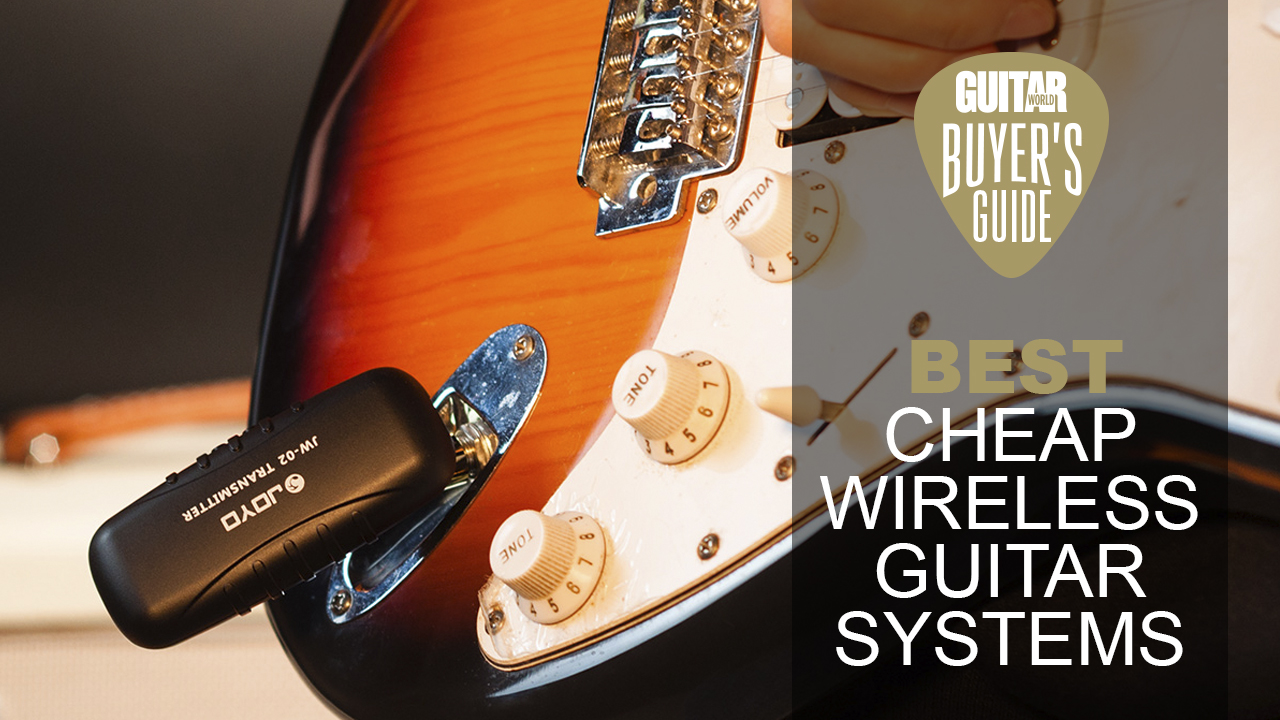
Best invention ever? The electric guitar of course. Worst invention? Cables, the bane of every guitarist’s life. The solution? Invest in one of the best cheap wireless guitar systems. They’re no longer the preserve of wealthy rockstars and can be picked up for little more than the cost of a budget meal for two.
Disentangling yourself from your guitar and amp isn’t just about enjoying a more comfortable playing experience, it’s about creativity. It grants you the freedom to express yourself wherever you like, without being tied to a corner of your practice room or the same few, sad, square meters of the stage. It’s quite literally a release from the shackles that constrain our imagination, our inventiveness, our grand vision! It also makes it easier to reach for that coffee, or walk over to wake up the drummer.
But aren’t they horribly complicated to set-up? Not anymore. Most are plug ‘n play, so the worst you’ll have to face is selecting different channels for each member of your group.
To help you choose the best budget system for you, we’ve assembled a list of some of the finest inexpensive wireless guitar systems you can buy. At the end of the guide, we've also included some in-depth buying advice for those who'd like to read more about the best cheap wireless guitar systems, which can be found by clicking the link. If you'd rather just get to the products, then keep scrolling.
Best cheap wireless guitar systems: Guitar World recommends
Behringer is renowned for bringing us high-level kit at low-level prices, and yet again it's delivered with the Airplay Guitar AG10 wireless system. The range is excellent, battery life is outstanding and audio quality is as good as any other product here. Operation couldn’t be more straightforward and there are four frequency channels on tap if you need them.
The AKG WMS 40 is one of the more expensive options here, but it’s more substantial than some of the dongle-type systems. It also uses the UHF frequency band, which can be more reliable than 2.4GHz, and its battery life stretches into eons.
The WMS 40 is also part of a larger AKG ecosystem, making it a neat solution for singer songwriters who occasionally need to rig up a wireless mic with the same kit.
Best cheap wireless guitar systems: Product guide
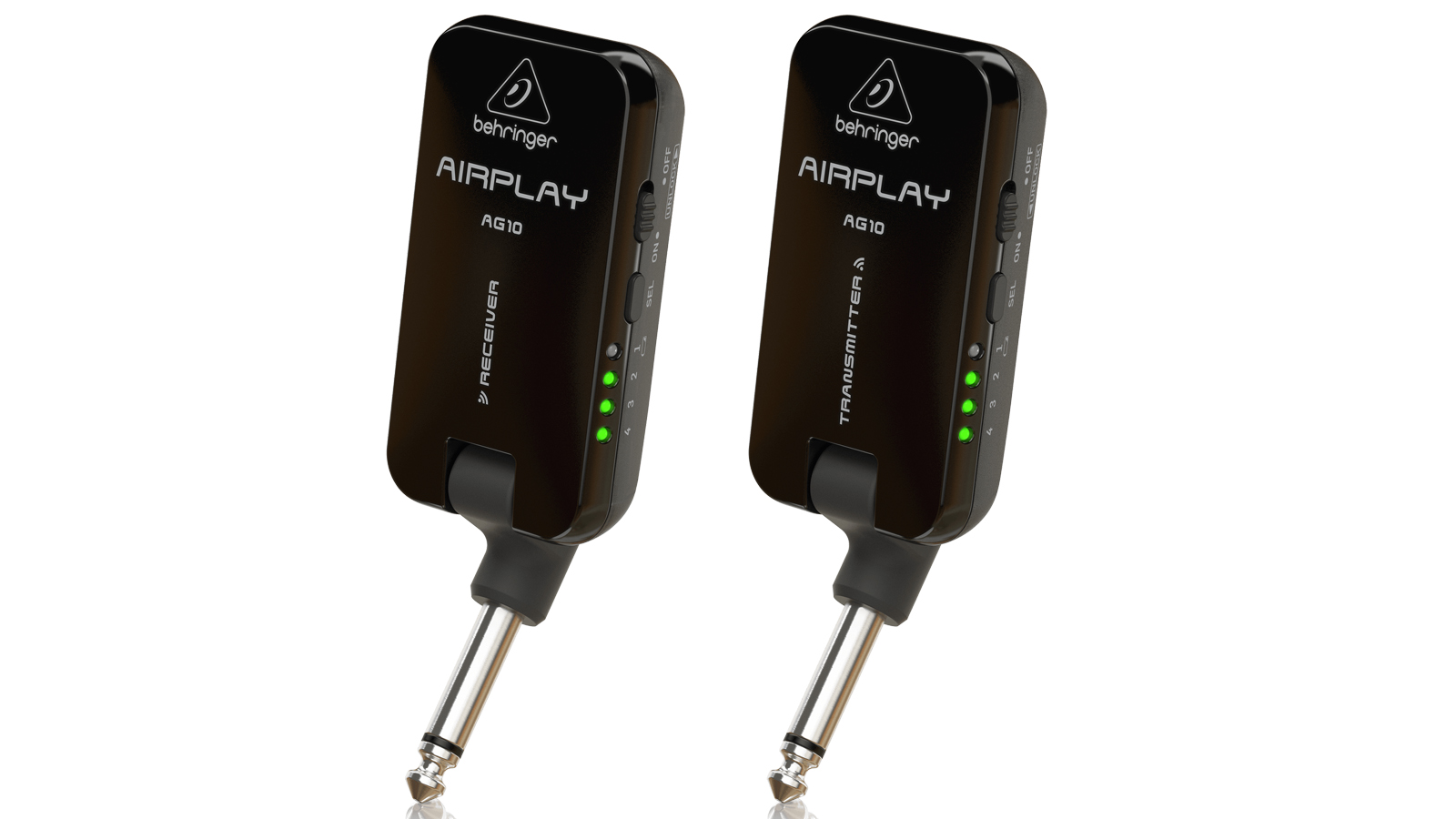
1. Behringer Airplay Guitar AG10 Digital Wireless Guitar System
Our expert review:
Specifications
Reasons to buy
Reasons to avoid
Trust Behringer to come up with the goods at a knockdown price. This is a wireless system that seems impossibly well-specced for the cost, and Behringer throws in a three-year warranty too.
You get pristine 24-bit / 48kHz audio quality, low latency, up to six hours of battery life and a decent 30 meters of range. Operation is simplicity itself, just plug in and go. You also get the option to switch to one of four channels, so that you can play with similarly equipped bandmates or avoid clashing with another guitarist in a multi-band setting.
Both receiver and transmitter feature lithium-ion batteries that can be recharged over USB.
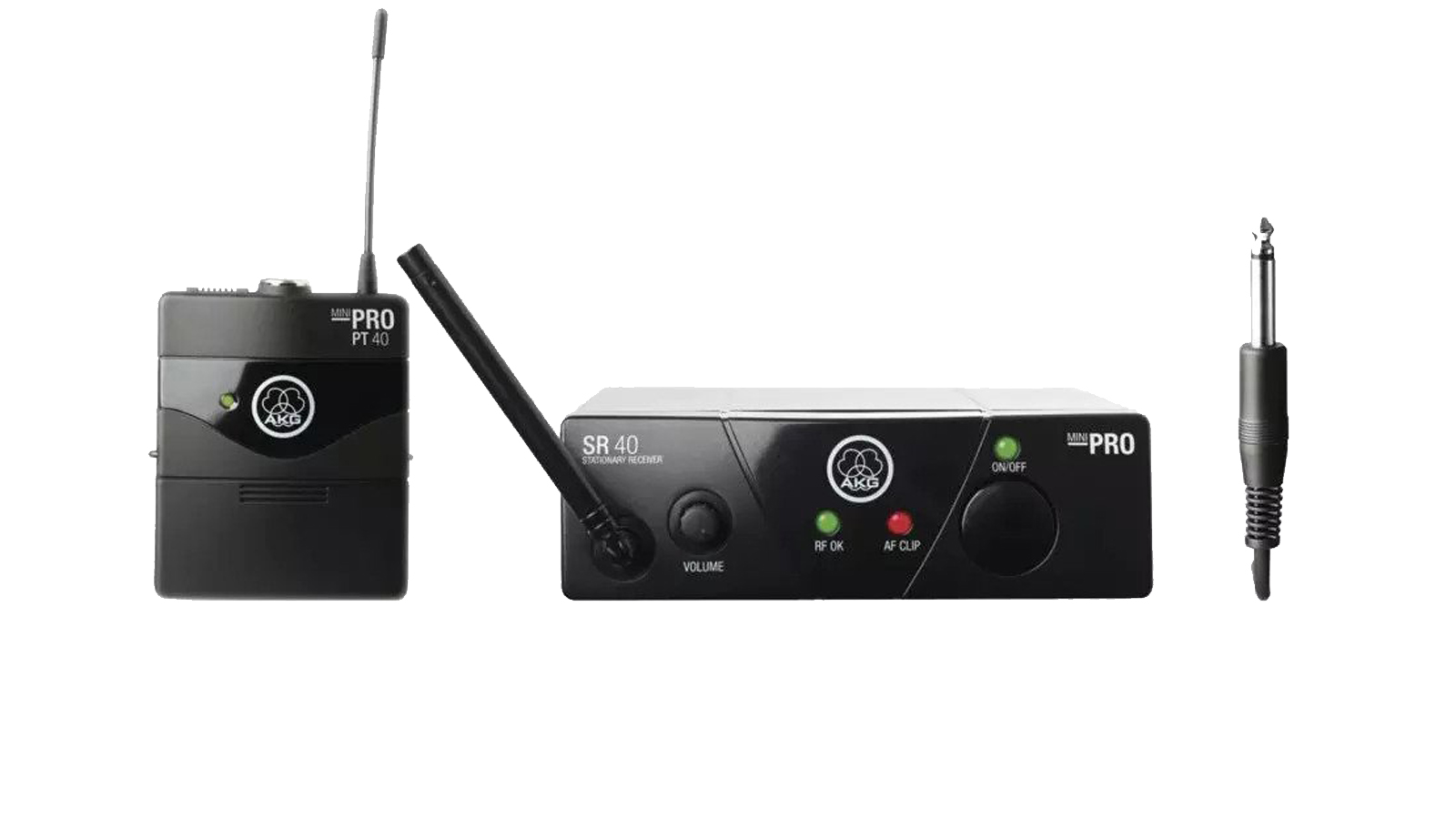
2. AKG WMS 40 Mini Instrument
Our expert review:
Specifications
Reasons to buy
Reasons to avoid
The WMS 40 isn’t as discreet or portable as some of the systems in this guide, but it does have a place in semi-permanent installations – such as a practice room – or where the 2.4GHz band is too crowded for reliable performance.
Instead of using a small dongle-like transmitter and similarly shaped receiver, it features a more traditional mains powered base station that communicates with a body-pack transmitter. The transmitter, which takes a single AA battery, is compact enough to slip into a pocket or can even be strapped or taped to your guitar.
Why bother with such a cumbersome set-up? Battery life is an awesome 30 hours, providing a full month’s playing time for those of us who practice for an hour a day. It’s also easy to pair the transmitter with a microphone, making this an excellent solution for singer songwriters. Sure, it’s possible to rig dongle-type transmitters up with mics too, but this is a more elegant solution.
The WMS 40 transmits using UHF frequencies, so AKG makes distinct versions to comply with legislation in different parts of the world. You should be able to find the correct model for your location but check local requirements before dropping it in your virtual shopping basket.
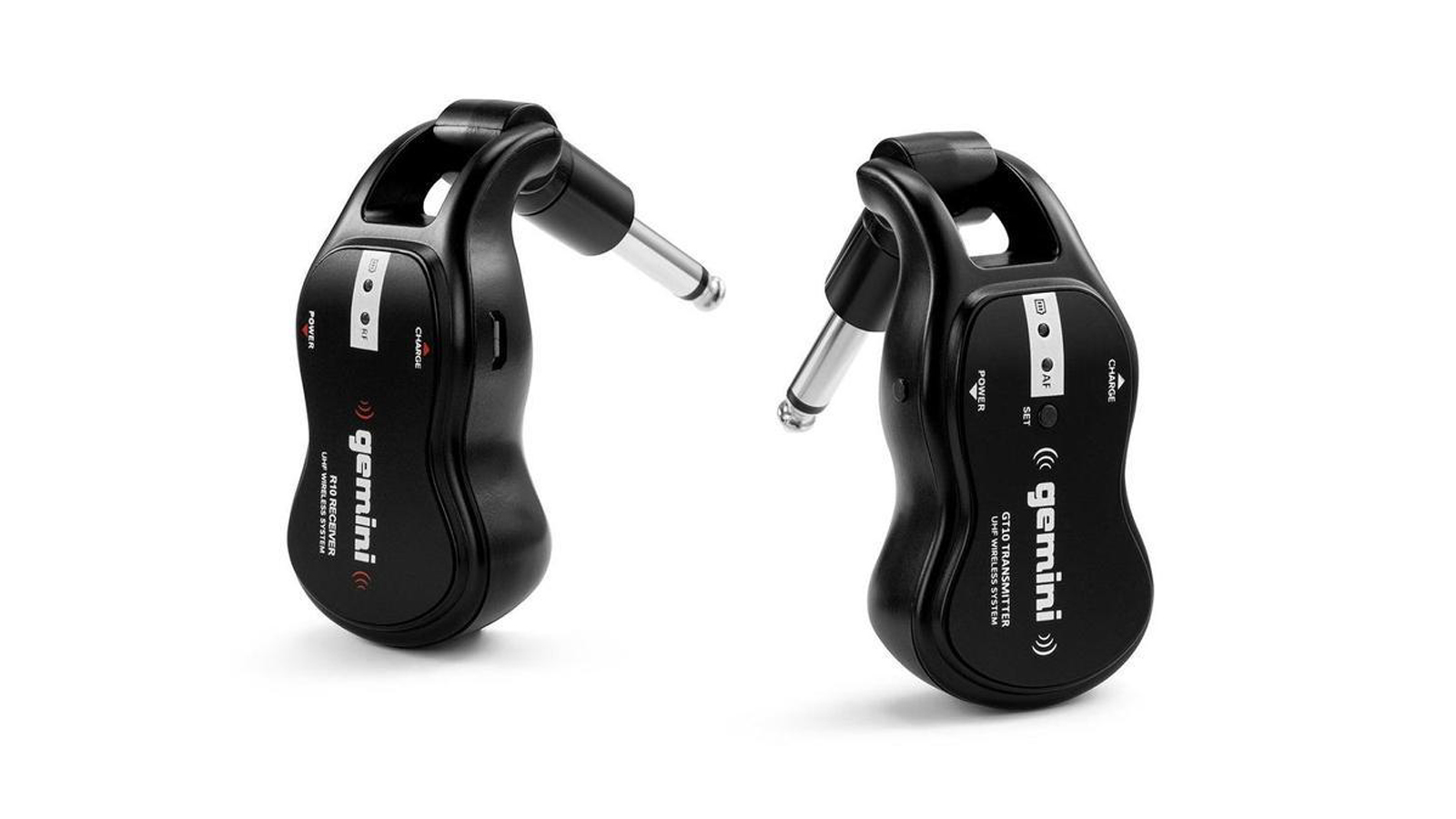
3. Gemini GMU-G100 UHF
Our expert review:
Specifications
Reasons to buy
Reasons to avoid
Here’s proof that you don’t always have to sacrifice features when buying on a budget. For less than $50 the GMU-G100 system provides the walkabout guitarist with everything she or he could wish for in a wireless set-up.
It’s dead easy to use. Just plug in and the transmitter will automatically pair with the receiver. Then, if you need to change channel, just press the Set button to find one that’s free.
Range is an impressive 50 meters, which is more than enough for small gigs, and there’s enough poke in the batteries to last hours in the practice room. Both transmitter and receiver contain Lithium batteries that can be charged over USB.
If your playing buddies fall in love with this system too, don’t worry – the GMU-G100 supports up to six pairs of devices and can even transmit one signal to several receivers for creative multi-amp set-ups, and also works fine with active electric guitar pickups.
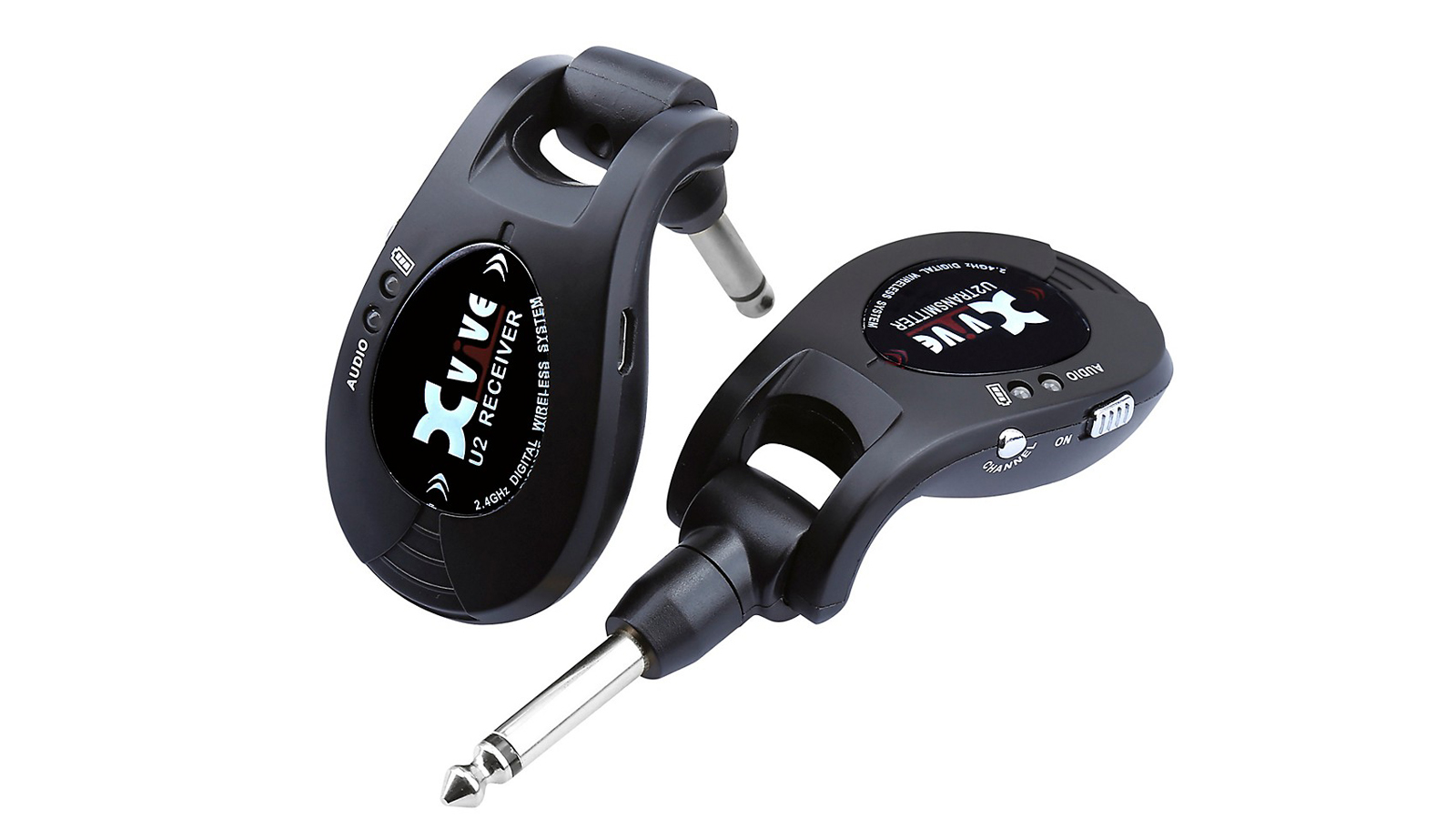
4. XVive Wireless System U2
Our expert review:
Specifications
Reasons to buy
Reasons to avoid
The XVive U2 is a very popular, widely available wireless system, but at around $150/£100 it is nudging the top end of cheap. So, what does the extra outlay buy you?
Like many of the other systems here, it’s completely plug ‘n’ play. Just plug it in and forget it’s even there as you take off around the stage. Its 21m range is nothing to write home about, but it’s typical for a 2.4GHz system. At least you’ll be in a position to write home about something, as you’ll be able to travel freely around the world with the U2.
Your tone’s in great hands too. Latency is very low at 5ms, so your playing can remain fluid, and it’s capable of 24-bit / 48kHz audio, which is pretty outstanding.
The onboard rechargeable lithium batteries last for a very healthy session-busting five hours, and it’s available in a variety of funky colors to coordinate with your guitar, T-shirt, tutu, tour bus or hair – black, carbon, silver, gold, redwood, blue, red and sunburst. Sunburst colored hair is a thing isn’t it?
The U2 will work with active pickups, provided their output voltage is less than 5.6Vp-p.
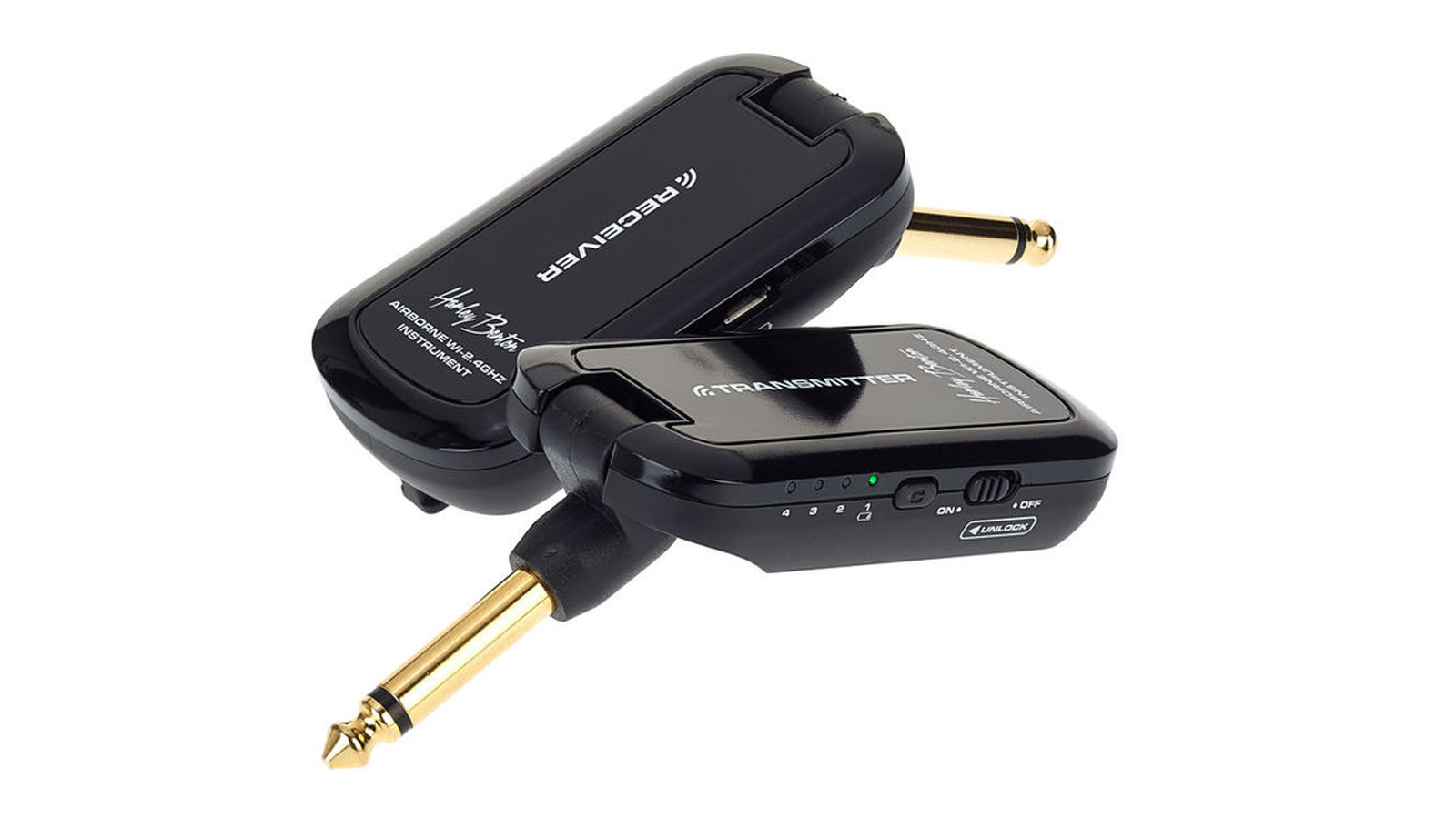
5. Harley Benton AirBorne 2.4Ghz Instrument
Our expert review:
Specifications
Reasons to buy
Reasons to avoid
Harley Benton is part of Musikhaus Thomann, one of the world’s largest musical instrument retailers, so it has real insight into what customers need from a product. Frankly, it doesn’t leave us wanting with its Airborne wireless system.
First off, it’s stonking value at just £59. The two components, transmitter and receiver, also look smart, if a little business-like, in their black plastic housings. They certainly don’t resemble a bargain basement buy.
The rest of the spec is up with the best here. Less than 5ms latency, 30m range, four available channels, 2.4GHz operating band and six-hour life from the internal rechargeable batteries. A solid buy.
The only fly in the ointment is that Harley Benton warns that the Airborne won’t play nicely with active pickups, which is a shame.
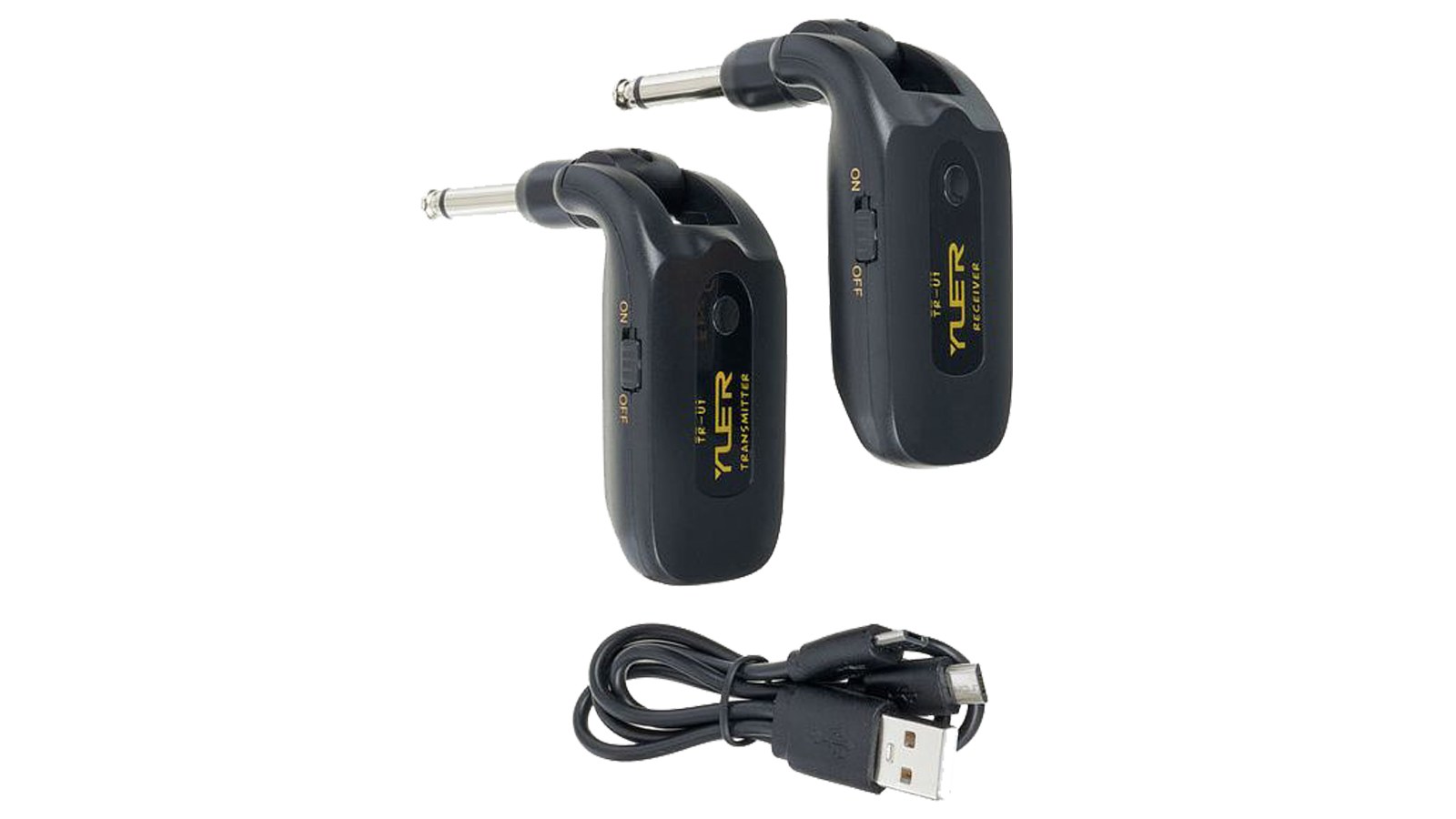
6. Yuer TR-U1 Wireless System
Our expert review:
Specifications
Reasons to buy
Reasons to avoid
This is about as cheap as it gets for a wireless guitar system. Would we trust it on the Coachella Stage in front of thousands of adoring fans? We’ll let you know, we’re still waiting on the invite… Would we trust it for bedroom practice and for small gigs? Absolutely.
The TR-U1 can pretty much match every other system in this guide feature for feature, except when it comes to battery life. It’s better, much better. Yuer claims an astonishing 10 hour run time for the diminutive TR-U1. That’s more practice than many of us do in a week.
Shredders and bass players beware – unfortunately it’s incompatible with active pickups.
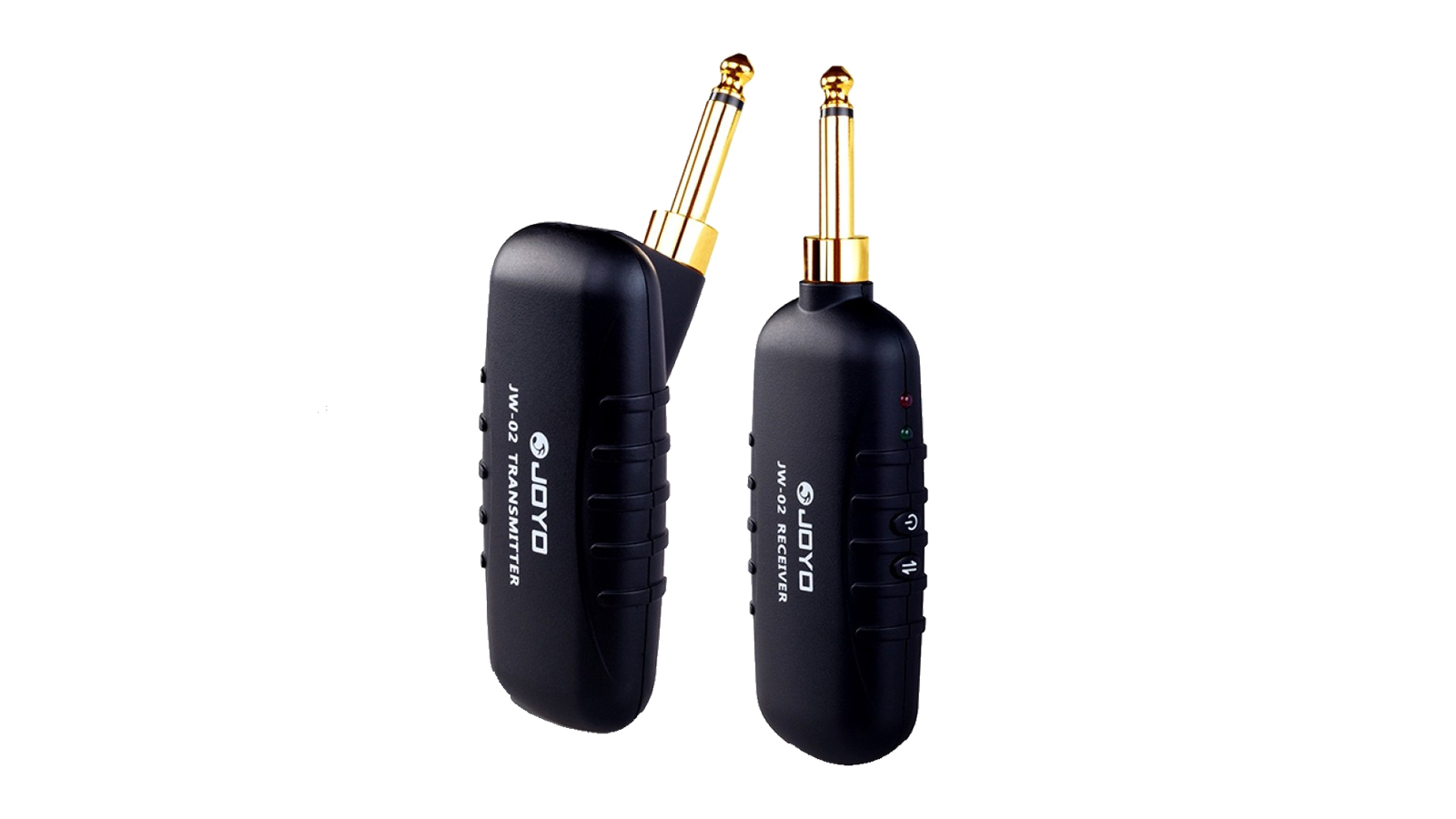
7. Joyo JW-02 Wireless System
Our expert review:
Specifications
Reasons to buy
Reasons to avoid
The 2.4Ghz frequency band has a lot going for it, not least the fact that it’s legal all around the world. However, these advantages come at a cost: it’s a popular slice of the airwaves, which means it can get crowded. This can lead to all sorts of undesirable issues from dropouts to interference.
The JW-02 system, which uses the less popular and less crowded 5.8GHz band, could be a good solution for you if you’re experiencing hiccups with 2.4GHz. Signals sent over 5.8GHz are usually cleaner, clearer and faster, but may suffer slightly in range. It’s also not legal to use this frequency band across the entire planet, so check local legislation before buying.
The rest of the JW-02’s specs are pretty solid, making it a good buy, especially if you’re getting crowded out of the 2.4GHz band.
Best cheap wireless guitar systems: Buying advice

We now live in such a wireless world that we tend to take the convenience of our unshackled lives for granted. Hand tools, kettles, vacuum cleaners, telephones, internet connections and so on have been wireless for decades, so why do many of us still play guitar while buried in a nest of cables?
Perhaps it’s because wireless guitar systems used to be tone-suckingly unreliable, tricky to set up and very expensive. But no longer. Modern systems sound great, suffer fewer dropouts, are plug ‘n’ play and needn’t be expensive. So, what should you look for when choosing a wireless guitar system?
A simple two-part system
You can trust Guitar World
Wireless systems comprise just two parts, a transmitter and a receiver. At the budget end of the market most transmitters and receivers look a little like small dongles with ¼ inch jacks. However, some transmitters can take the form of a small body pack, and these are likely to communicate with a mains-powered base station.
Turn everything on and, hey presto, you’ll be living a life without wires. It’s that simple.
Whatever the appearance, budget systems work in a similar way. All you need to do is plug the transmitter into your guitar and the receiver into your guitar amp. Turn everything on and, hey presto, you’ll be living a life without wires. It’s that simple.
Range
Most budget systems can manage a range of 20 meters plus, some even twice that or more. Often, depending on the technology used, this distance will be line of sight, so don’t expect to be able to plonk your amp in the next postcode. The bottom line is that even inexpensive wireless systems have enough poke to be useful in bedrooms, modest practice rooms and small performance venues.
Sound quality
Many of the systems in this guide boast broad frequency range, 24-bit / 48kHz audio, which is almost as good as it gets. Trust us, provided your signal isn’t suffering from interference (see below) you’ll be hard pressed to tell the difference between your wired and your unwired tone.
Of course, for critical recordings you can always dig out your favorite guitar cable again.
What’s the frequency Kenneth?
For most users, most of the time, we recommend buying a 2.4GHz system. That’s because 2.4GHz, which is the radio frequency the transmitter uses to communicate with the receiver, is relatively fast, has a decent range and, importantly, is legal all over the world.
The only issue is that the 2.4GHz band can be quite crowded because so many devices, including your wi-fi, use it. So, if you live in a densely populated area you may suffer dropouts and interference.
One solution to this problem is to use the 5.8GHz band, which is often less congested. 5.8GHz is faster, so latency is lower, but its range isn’t quite as good. Using this frequency may require a license in some regions too.
UHF frequency systems that use the (roughly) 600MHz to 900MHz band are another solution worth considering. These frequencies are even less prone to congestion, making them ideal for multi-instrument set-ups. Not all frequencies within this range are legal in all territories though, so you’ll need to buy a system that’s localized to your region.
If all this sounds a bit too complicated, don’t worry. At the budget end of the market most systems use 2.4GHz, which is fine for the vast majority of users.
Channels
Show your shiny new budget wireless system to your bandmates and we guarantee that they’ll all want one too. But how do you stop your transmitter talking to your bass player’s receiver? Most of the systems in this guide can transmit and receive on up to four distinct channels. Provided you’re playing on a different channel to your bandmates then everything will be hunky dory and your signals will remain separate.
Changing channels is usually just a matter of pressing a single small button to cycle through them. Simples.
Battery life
Years ago, before modern rechargeable batteries became the norm, wireless systems would rip through standard AA batteries at an alarming rate, which was both costly and inconvenient.
These days most dongle-type transmitters and receivers can be fully recharged over USB within two or three hours. You can expect to get between four- and six-hours playing time from a full charge, which is more than enough for a practice session or gig.
Related buying guides
- Plug in to one of the best electric guitars
- Consider one of the best electric guitars under $1,000
- Or one of the best cheap electric guitars under $500, if you're on a budget
- Playing at home? Look at the best practice amps
- Or maybe check out the best guitar amp headphones
- Having one of the best guitar tuners is crucial
- Lose your head in the best headless guitars
Get The Pick Newsletter
All the latest guitar news, interviews, lessons, reviews, deals and more, direct to your inbox!
When Simon's childhood classical guitar teacher boasted he 'enjoyed a challenge', the poor man had no idea how much he'd underestimated the scale of the task ahead. Despite Simon's lack of talent, the experience did spark a lifelong passion for music. His classical guitar was discarded for an electric, then a room full of electrics before Simon discovered the joys of keys. Against all odds, Simon somehow managed to blag a career as a fashion journalist, but he's now more suitably employed writing for Guitar World and MusicRadar. When not writing or playing, he can be found terrifying himself on his mountain bike.
“Our answer to everything players have asked for and more”: Neural DSP’s Nano Cortex had one major drawback – but now it’s been addressed with a huge free firmware update that takes on Kemper and TONEX
“One of the most genuinely unique guitar tones I’ve ever heard”: Submarine Pickups Subsix review











